You’ll Never Guess This Titration Meaning ADHD’s Tricks
Understanding Titration and Its Meaning in the Context of ADHD
In recent years, the understanding and treatment of Attention Deficit Hyperactivity Disorder (ADHD) has grown more sophisticated, causing improvements in numerous treatment procedures. Among these innovations, titration stands apart as a process that plays an essential role in efficiently handling ADHD symptoms. This post intends to dive into the meaning of titration in the context of ADHD, analyzing its significance, methods, and FAQs to offer detailed insight into how this idea fits into the broader landscape of ADHD management.
What Is Titration?
Titration is a scientific term mainly utilized in chemistry to explain the gradual addition of a substance, typically a reagent, to a service in order to attain a preferred concentration. In the medical field, especially in managing persistent health conditions such as ADHD, titration describes the mindful adjustment of medication dosage to attain optimum effectiveness with very little side effects.
The essential components of titration in ADHD treatment consist of:
- Stepwise Adjustment: Medications are administered in controlled increments.
- Tracking: Continuous observation of the client’s reaction to the medication.
- Feedback Loop: Adjustments are made based upon client feedback and observed outcomes.
The Importance of Titration in ADHD Management
Titration is a crucial aspect in the treatment of ADHD for several factors:
-
Individual Variability: Each individual reacts differently to medication. Titration enables health care specialists to customize treatment based upon the distinct needs of the client.
-
Reducing Side Effects: Gradually adjusting does helps in determining the ideal dose that reduces symptoms while decreasing unfavorable impacts, producing a balance that is necessary for client comfort.
-
Improving Efficacy: By keeping track of the client’s condition, health care service providers can figure out the most efficient dose faster, resulting in much better management of ADHD signs like negligence and hyperactivity.
-
Patient Involvement: Titration often involves the client or their guardians in reporting modifications in behavior or cognition, cultivating a collaborative technique to treatment.
Titration Process in ADHD Treatment
The titration process in the treatment of ADHD medications typically follows numerous steps:
-
Initial Assessment: The healthcare company conducts an extensive evaluation, including case history, sign assessment, and perhaps mental testing.
-
Beginning Dose: A preliminary dose of medication is recommended based on clinical standards and client qualities.
-
Routine Follow-ups: The client’s reaction is examined at routine intervals (e.g., weekly or bi-weekly). This involves checking in on symptoms and side effects.
-
Dose Adjustment: Depending on the client’s feedback and health status, the supplier might increase, decrease, or switch medications.
-
Long-term Monitoring: After reaching an ideal dose, continuous evaluations are still important to guarantee continued efficiency and to make any essential adjustments.
Table 1: Common ADHD Medications and Their Initial Dosage Titration
| Medication Name | Beginning Dose | Incremental Adjustment | Optimum Dose |
|---|---|---|---|
| Methylphenidate | 5 mg/day | +5 mg weekly | 60 mg/day |
| Amphetamine | 5 mg/day | +5 mg weekly | 40 mg/day |
| Dexmethylphenidate | 2.5 mg/day | +2.5 mg weekly | 20 mg/day |
| Atomoxetine | 40 mg/day | +20 mg after 3 days | 100 mg/day |
Keep in mind: It’s vital for patients to follow their health care supplier’s particular titration plan, which may vary from these basic standards.
FAQs about Titration and ADHD
1. For how long does Titration Meaning Adhd take?Titration duration can vary considerably from client to client, often taking several weeks to months. It depends upon how rapidly the client reacts to medication and the modifications required to find the optimum dose. 2. Are there risks associated with titration?While titration istypically safe, the threats consist of possible negative effects that
may take place as does are adjusted. Close monitoring by a doctor helps reduce these risks. 3. Can titration use to non-stimulant medications?Yes, titration is applicable to both stimulant
and non-stimulant medications utilized to deal with ADHD. For non-stimulant
medications, the modification process might include various does and timelines. 4. How can moms and dads help during medication titration?Parents can support the process by keeping a detailed record of their kid’s habits, noting any changes in signs or negative effects, and interacting this information to
the doctor. 5. What should I do if I experience negative effects throughout titration?If side effects take place, it’s crucial to call the health care company immediately for guidance. They may change the medication or dose based on the reported symptoms. Titration plays a key function in the personalized treatment of ADHD, allowing health care service providers to adjust medication does based upon specific reactions and requirements. With mindful tracking and incremental adjustments, titration helps with optimal
management of ADHD symptoms while decreasing negative effects, paving the method for enhanced lifestyle for patients. As our understanding continues to evolve, the focus on personalized care stays necessary in achieving the finest possible results for those affected by ADHD.



